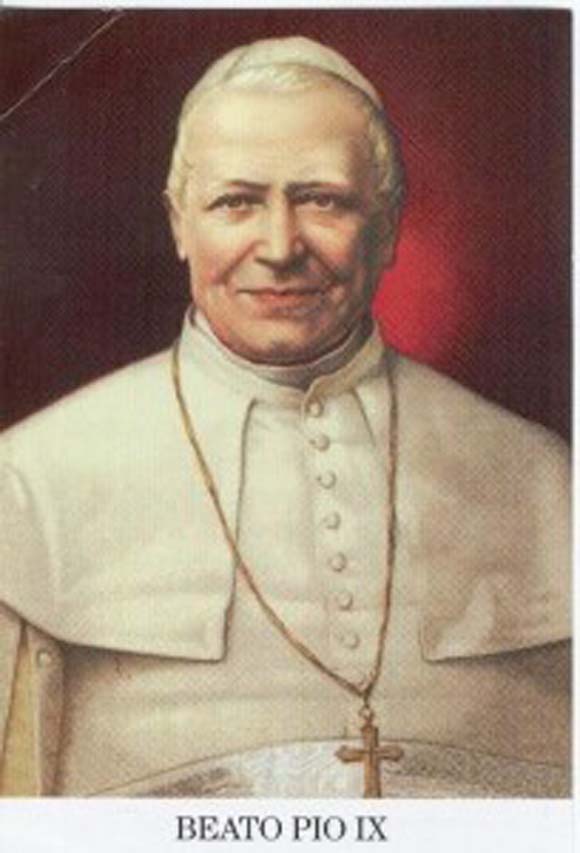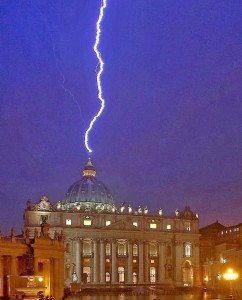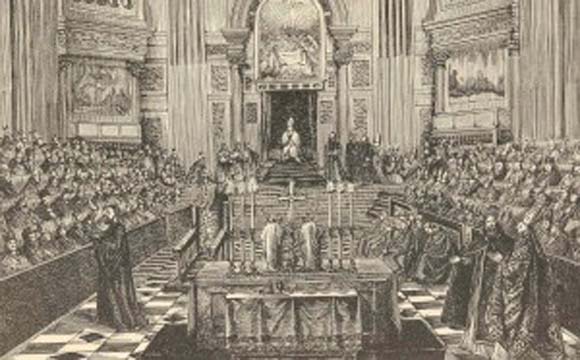
Councils of Faith: Vatican I (1869-1870)

Unlike Trent and Vatican II, those two great councils that have radically shaped the Catholicism of the modern world, the First Vatican Council might appear insignificant and bizarre to us. This short council, lasting only eleven months, was held in the Vatican Basilica amidst great anxiety in Rome, and indeed the unease lay heavy across the Catholic world. Vatican I is now remembered chiefly for defining Papal Infallibility, but the real picture is more interesting than that.
Three centuries after Trent, the Catholic faith seemed embattled on all fronts: the onslaught of rationalism, materialism and liberalism – whether in the philosophical, scientific, or political spheres – seemed to threaten the very existence of the Church, let alone its relevance to modern nation states. Indeed, by the late 1860s Italian unification left only Rome under the pope’s control, shielded for now by French troops. Pope Pius IX, or ‘Pio Nono’, as he was affectionately known, was doggedly attached to the ‘temporal power’, which was anachronistic even for the 19th century.
Many bishops, priests and laity lamented the Pope’s political predicament – especially those with ‘Ultramontane’ sympathies – but the wider concerns were actually doctrinal and disciplinary. The Church needed to restore the purity of the faith, the dignity of worship, morality and discipline, the education of priests, ecclesial obedience, care for the youth, and to work towards international peace, and above all, Christian unity. The Syllabus of Errors (1864) had denounced many aspects of ‘modernity’ that threatened the faith, such as the closure of church schools, but this collage of condemnations was ill-received and caused ‘Liberal Catholics’ to despair of any reconciliation between the Church and modern societies. The Syllabus was not wrong as such, as the Liberal bishop Dupanloup was at pains to prove, but it was imprudent, impolitic, even downright incompetent to have issued it in such a way and amidst such controversy.
One might even say, ‘inopportune’. That was the word dominating the Infallibility debate. Among the bishops and theologians, many agreed with Papal Infallibility but felt the time was ‘inopportune’, for pragmatic and political reasons, to define it dogmatically. Only a tiny minority actively denied that the Pope was infallible. Since the Holy Spirit had been given by Christ to preserve his Church from error in matters essential to salvation (cf. John chs. 14-16, esp. 16:13), and this Church had been built on the faith of Peter ‘the Rock’ (cf Matthew 16:18), how could we not trust the Pope to teach truthfully? Indeed, it is a remarkable fact that no pope speaking ex cathedra on faith or morals has ever been shown to be in error.
Against these two groupings, the Infallibilist majority was actively campaigning for a dogmatic definition, especially the Jesuits. Some Infallibilists took a strong line (that all papal utterances are infallible), but the more sensible ones wanted a limited definition that would strengthen papal authority at a time of great crisis and bring a satisfactory resolution to centuries of theological development on this topic. The matter was especially pressing after the dogmatic definition of the Immaculate Conception in 1854 seemed to imply papal infallibility. But infallibility should not be confused with ‘inspiration’ or ‘inerrancy’. As Pio Nono himself joked, ‘I’m not infallible in choosing my snuff!’
Note that this limits the definition of infallibility to very specific circumstances; so it was a great blow to the rigorist Ultramontane party. Though the truth of the decree did not depend on their consent, it is significant that all the inopportunist bishops, even the most implacable (such as Dupanloup, Hefele, and Strossmayer), rallied round the definition in due course. As Ronald Knox later pointed out, since Catholics believe in the infallibility of the Church, especially through General Councils, and since a General Council defined Papal Infallibility, a Catholic must hold that definition to be infallible!
That is why the other side of Vatican I, the dogmatic constitution on the Catholic faith, Dei Filius, which was passed unanimously, must not be overlooked. This important document affirmed that natural human reason could yield knowledge of God; that faith is not blind; that Holy Scripture must be interpreted in line with Holy Mother Church; and that the Church’s global expansion, Catholic unity, and stable faith, all proved the divine origin of her mission.




